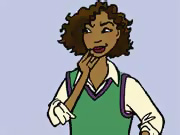What does Ms. Milton need to know about students with visual impairments?
Page 1: Overview of Visual Impairments
 Since the first grade, Evan and Emily have received their education in the general education classroom. They have recently moved and will attend a new school this year. Ms. Milton has just learned that Evan and Emily will be in her third-grade class.
Since the first grade, Evan and Emily have received their education in the general education classroom. They have recently moved and will attend a new school this year. Ms. Milton has just learned that Evan and Emily will be in her third-grade class.
Though she is excited about the opportunity to work with these students, Ms. Milton is also a bit nervous about her ability to meet their needs. The twins will require some accommodations if the general education curriculum is to be accessible to them. With the help of key individuals, Ms. Milton will work to minimize their differences and maximize their learning opportunities.
What does it mean to have a visual impairment?
The term visual impairment encompasses both blindness and low vision. Visual impairment refers to any level of vision loss that affects an individual’s ability to complete everyday tasks. Individuals with visual impairments may have considerably different levels of visual functioning, and they use what vision they have in different ways.
 Low Vision
Low Vision
Emily has low vision. This means that she has a significant loss of vision that cannot be fully corrected by glasses or contact lenses. Emily performs everyday tasks using visual strategies:
- Assistive technology (e.g., closed-circuit television)
- Environmental accommodations (e.g., the use of high-contrast materials)
- Materials in alternative formats (e.g., large print)
 Blind
Blind
Evan is blind. He uses his tactile and auditory senses most effectively for learning, as opposed to using vision. Evan performs daily tasks using:
- Assistive technology (e.g., Perkins Brailler)
- Orientation and mobility skills (e.g., using a long cane)
- Materials in alternate formats (e.g., audiotapes)
- Environmental accommodations (e.g., the use of tactile warning strips at edges of stairs)
Listen to the advice Betsy Belknap offers to general education teachers about students with visual impairments (time: 1:26).

Transcript: Betsy Belknap
With the ongoing daily interaction with the general ed. teachers, it works out real well. We work as a team. We discuss upcoming lessons and assignments and how materials can be adapted. We also can talk to each other about any concerns we have, anything we’ve seen going on with the child that we might need to address. I give the teachers information they need, like the accommodations the child might need, their vision needs, and if there’s any other disability or health concerns that they should be aware of. I give them folders and blank work-request forms to make it convenient for them to give me the materials that I need to adapt. I braille or enlarge everything that the regular ed. kids are doing, provide tactile illustrations and maps and models to help enhance their understanding in the regular classroom. I try to get everything prepared ahead of time and get it there so we have it right when we need it. That’s where working closely with the classroom teacher is really, really important. And also during the year, my aides and I provide extra support within the classroom, if needed. If there are any concerns or any hesitation on the part of the general ed. teacher, we want to make sure we make them feel comfortable and address those concerns.
Additional information about teaching students with visual disabilities can be found in the following IRIS Modules: